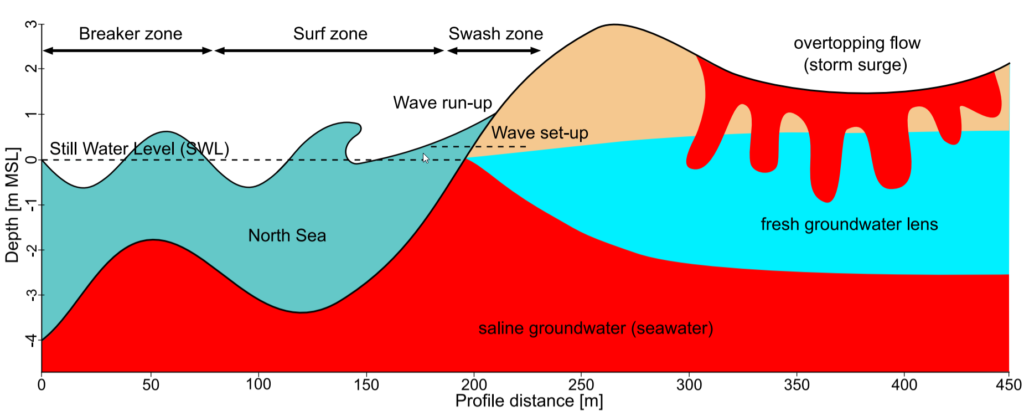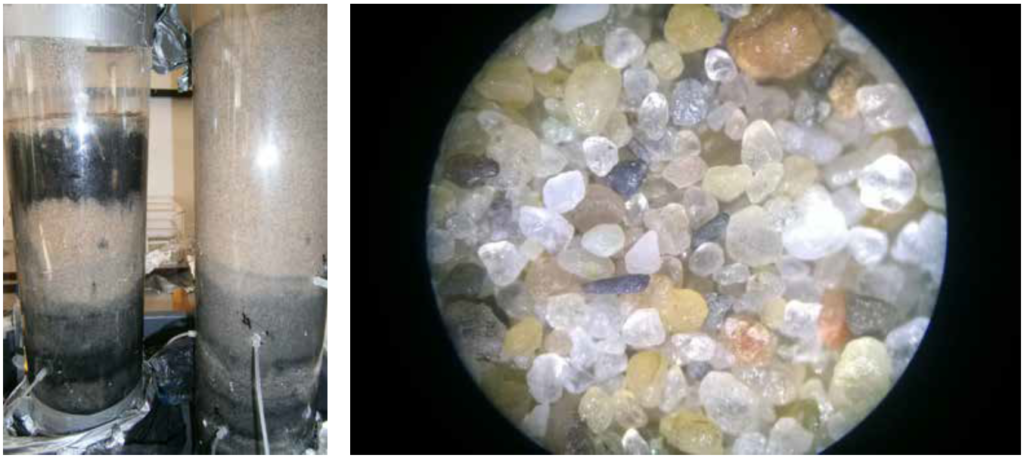Hydrology and geochemistry
The placement of the Sand Motor had large effects on the fresh groundwater resources, which turned out to be strongly related to the tides, waves and the spreading of the sand. In addition, the biogeochemical properties of the sediment, which became exposed to the atmospheric conditions after placement, have been investigated. The latter research focused on the environmental chemistry of beach nourishments and whether the quality of the applied sand on a beach may result in an environmental risk for people, plants and benthos.
Impact on fresh groundwater resources
by Sebastian Huizer
Most coastal regions around the world rely on groundwater as their primary source of freshwater. Excessive groundwater extraction, population growth, sea-level rise, and increases in storm surges threaten the availability of freshwater in many, often densely populated, coastal communities. To protect vulnerable coastal areas, an optimal management of the coast and coastal fresh groundwater should be adopted.
This research investigated the possibilities of large sand nourishments such as the Sand Engine to increase fresh groundwater resources, and simultaneously help to maintain and protect sandy coasts.
One of the most surprising and interesting aspects of this research was obtained with the intensive monitoring study on the Sand Engine. In this monitoring study geophysical measurements (electrical resistivity topography) were conducted along a 2-D transect for period of two months. These measurements showed the effects of tides and storm surges on a coastal aquifer with a fresh groundwater lens. The observed changes in groundwater salinity due to groundwater recharge, tidal dynamics, and storm surges could to a large extent be simulated by a variable-density groundwater model, suggesting that given a thorough understanding of the (local) system, groundwater models can be used to make predictions of the effects of tides and storm surges.
Mega-scale beach nourishments such as the Sand Motor can lead to a substantial increase in fresh groundwater resources. This suggests that local mega nourishments might be an effective solution for low-lying coastal regions. Especially for countries that suffer from droughts or salinization, which sometimes coincide with inundation of the coasts. Large-scale sand nourishments may become an interesting solution for some areas, to protect the hinterland and preserve and increase fresh groundwater resources.

Ecological risks from geochemical processes
by Iris Pit
The sand used for the Sand Motor originates from two different geological layers: a Holocene marine layer (up to 12,000 years old) overlies Pleistocene fluvial sand (between 12,000 and 2 million years old). Because the sand comes from different time periods with a varying sea level, the sand showed chemical variations, with the Holocene sands containing many more reactive minerals compared to the Pleistocene sands.
The Pleistocene layer had some surprises, like bog iron ore (5-20 cm large orange/ brown rocks) and layers of shells.
The amount of bog iron ore and shell material at the surface of the Sand Motor has increased over time, as the fine sand is transported more easily by the wind than the bog iron ore and shells.
Scientific research on chemical processes that may cause a potential environmental risk on beach nourishments has not been investigated before. Hence, the chemical processes present on a beach that may dissolve trace elements like heavy metals were investigated. With the comparison of different beach nourishments, it was studied which type of nourishment is preferred with respect to environmental chemistry.
The design of a beach nourishment shows to be the most important factor for potentially environmental risks, mainly for benthos. It was found that a beach nourishment well above sea level such as the Sand Motor is influenced by oxygen and rain water. Atmospheric oxygen cause minerals in the sand to dissolve, which may affect the shallow groundwater.
In general, contamination is mainly present in the finer soil fractions, like clay, because of their high diversity in minerals and an overall negative charge. As a result, dredging companies make sure that not too much fine material is present in the sand used for beach nourishment.
This knowledge can be used to give advice on for example the design of the beach nourishment or the type of sand that can be used, in order to create an environmental friendly nourishment.

More information on these topics can be found in this book.
